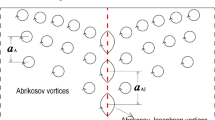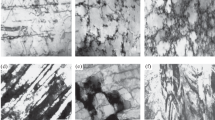Abstract
Experimental tests were made of the suggestion that the anomalously large magnitude and anisotropy of the resistive critical field of severely deformed niobium is due to the development of dense dislocation cell walls. The basis for the tests was the theoretical prediction that as the cell size approaches the coherence length ξNb for superconductivity, the superconducting properties of the cell walls would be smeared out over the entire micro-structure, destroying the anisotropy and a good part of the parallel critical field. Resistive measurements were made on swaged niobium wire and powder composites with true strains ranging up to 10.61, at temperatures from 4.2‡K to Tc. Two approaches were used: either by raising the temperature above 4.2‡K, ξNb could be enlarged, or by increasing strain the cell size could be reduced. The predicted effects were indeed observed; from the temperatures at which the anisotropy disappeared, values of ξNb were obtained which agree well with the expected magnitudes and variation of the cell size with cold work in drawn or swaged niobium.
Similar content being viewed by others
References
J. D. Livingston and H. W. Schadler:Progr. Mater. Sci., 1964, vol. 12, p. 185.
J. R. Pearson and R. M. Rose:Met. Trans., 1970, vol. 1, p. 377.
D. St. James and P. G. de Gennes:Phys. Lett., 1964, vol. 7, p. 306.
S. J. Williamson and J. K. Furdyna:Phys. Lett., 1966, vol. 21, p. 376.
J. E Peck: Ph.D. thesis, Department of Metallurgy, M.I.T., Cambridge, Mass., 1963.
D. K. Bowen, J. W. Christian, and G. Taylor:Can. J. Phys., 1967, vol. 45, p. 903.
H. Conrad, S. Feuerstein, and L. Rice:Mater. Sci. Eng., 1967, vol. 2, p. 157.
J. O. Stiegler, C. K. du Bose, R. E. Reed, Sr., and C. J. McHargue:Acta Met., 1963, vol. 11, p. 85.
G. Langford, III: Sc.D. thesis, Department of Metallurgy, M.I.T., Cambridge, Mass., 1966.
A. C. Barber: Second House Colloquium on Superconductivity, held at the University of Erlangen-Nurnberg, 25 April 1969.
B. B. Goodman:Phys. Rev. Lett., 1961, vol. 6, p. 597.
J. J. Hauser and E. Helfand:Phys. Rev., 1962, vol. 127, p. 386.
D. R. Tilley:J. Phys. C, 1968, vol. 1, p. 293.
D. C. Hill, J. G. Kohr, and R. M. Rose:Phys. Lett., 1970, vol. 31A, p. 157.
W. De Sorbo:Phys. Rev., 1963, vol. 132, p. 107.
Author information
Authors and Affiliations
Additional information
Formerly a National Science Foundation Trainee, Department of Metallurgy and Materials Science, M.I.T., Cambridge, Mass.
Rights and permissions
About this article
Cite this article
Hill, D.C., Rose, R.M. Experimental tests of proposed relations between the critical field and dislocation cell structure of superconducting niobium. Metall Trans 2, 585–589 (1971). https://doi.org/10.1007/BF02663353
Received:
Issue Date:
DOI: https://doi.org/10.1007/BF02663353




